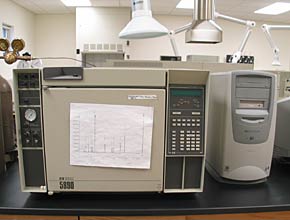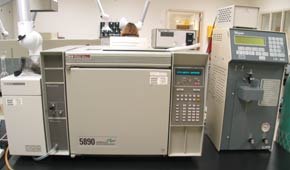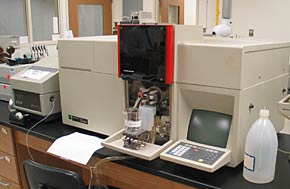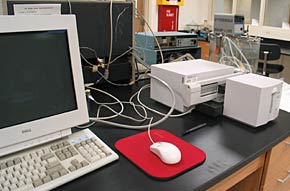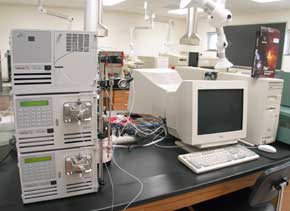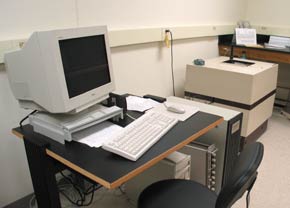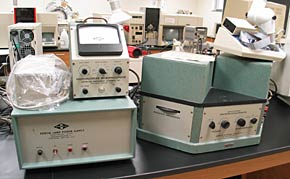Becoming skilled in the use of modern analytical instrumentation is an important part of modern undergraduate chemistry and biology curricula. Viterbo has an excellent collection of sophisticated instruments for chemical analysis, some of which students begin working with during their freshman year. Students use these instruments in a new, well-lighted, and pleasant state-of-the-art instrumentation laboratory in the Reinhart Center. The lab features networked PCs, lots of space, and excellent ventilation. Current equipment holdings are described below:
Hewlett Packard 5890A capillary gas chromatograph with flame ionization and electron capture detectors. Obtained with a grant from National Science Foundation. Gas chromatography is a technique to separate and quantify tiny portions of complex mixtures of volatile materials. The flame ionization detector (FID) does not detect water, so trace amounts of contaminants in aqueous samples can be detected easily. Electron capture (EC) is used mainly to detect very trace quantities of chlorinated or brominated materials such as DDT, PCBs, chloroform, and flame retardants. These materials do not readily biodegrade, and pose a potential health hazard in water supplies.
Hewlett Packard 5972 capillary gas chromatography with mass spectrometer detector. Obtained with a grant from the National Science Foundation. The mass spectrometer used in conjunction with the gas chromatograph not only is able to separate complex mixtures but also allows the analyst to identify and quantify specific components of the mixture by high speed ion fragmentation at less than nanomole (10-9 moles) levels.
Nicolet 210 Fourier transform infrared spectrometer. Obtained as a gift from Nicolet instruments, Madison, WI. The FT-IR is used mostly for qualitative analysis of organic and inorganic materials. It can be used for quantitative analysis. A spectral library allows unknowns to be identified by comparison of the unknown's spectrum against the file of library spectra. It requires high speed computing to process the information that is gathered in just a few seconds. The software allows the analyst to optimize the spectral parameters for the particular application.
Atomic absorption spectrophotometers. Perkin Elmer Model 1100B and PE 3030. Both instruments were gifts from the Northern Engraving Corporation, Sparta, WI. AAs are used to measure metals in ions solution at the part per million to part per billion range. Virtually any metal in the periodic table can be analyzed. They function by vaporizing a solution and converting ions to atoms for analysis using a high resolution photomultiplier detector sensitive to UV and visible light. The operator can select the wavelength suitable to any metal atom. The 1100B uses a high temperature furnace to vaporize solutions and atomize the metal ions, and is equipped with an automated sampling system for large numbers of samples. The 3030 aspirates the solution into an oxygen-acetylene flame.
HP 8453 and Varian DMS 100 ultraviolet and visible spectrometers. They are used for theoretical and analytical methods. Both instruments were obtained by grants from the National Science Foundation. Detection is based on the absorption of light by a sample. A diode array spectrometer passes the entire spectrum through the sample at once and uses a series of photodiodes and a computer to reconstruct the wavelength dependence of light transmission. The Varian is a traditional double beam scanning spectrophotometer that is much slower than the diode array instrument, but it is capable of much higher resolution.
Varian ProStar HPLC system with binary gradient pumping and dual wavelength UV-Vis detection. This instrument was obtained as a gift from the Xcel Energy Foundation. HPLC instruments are used to separate and quantify the components of a small volume of a liquid solution. The detection is by the absorption of UV or visible light. It can be augmented with auto-sampler and fraction collector for automated high throughput applications.
Anasazi Instruments Fourier transform nuclear magnetic resonance spectrometer. Obtained by a grant from National Science Foundation. This instrument uses a magnetic field in conjunction with pulses of radio frequency light to detect specific isotopes of hydrogen (H-1), carbon (C-13), phosphorus (P-31), boron (B-11), and other nuclei. It can quantify the relative number each chemically distinct nucleus of any type according to its "chemical shift." It is also able to measure the proximity of one nucleus to another by the magnetic interactions (splitting) of adjacent nuclei.
Used for theoretical and analytical determinations. Fluorescence occurs when a suitable material is irradiated with ultraviolet light and emits almost instantly light in the visible range. The rest of the energy is converted into internal motions of the molecule. The spectrofluorometer can measure the optimum excitation energy, and can quantify the material in question based upon the intensity of emitted light.
